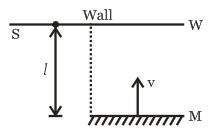Q. Electron in hydrogen atom first jumps from third excited state to second excited state and then from second excited to the first excited state. The ratio of the wavelengths $\lambda _{1}:\lambda _{2}$ emitted in the two cases is
Solution:

According to Rydberg formula
$\frac{1}{\lambda } = R \left[\frac{1}{n_{ f }^{2}} - \frac{1}{n_{ i }^{2}}\right]$
In first case, nf = 3, ni = 4
$∴ \frac{1}{\left(\lambda \right)_{1}} = R \left[\frac{1}{3^{2}} - \frac{1}{4^{2}}\right] = R \left[\frac{1}{9} - \frac{1}{1 6}\right] = \frac{7}{1 4 4} R … \left(\text{i}\right)$
In second case, nf = 2, ni = 3
$∴ \frac{1}{\left(\lambda \right)_{2}} = R \left[\frac{1}{2^{2}} - \frac{1}{3^{2}}\right] = R \left[\frac{1}{4} - \frac{1}{9}\right] = \frac{5}{3 6} R … \left(\text{i} \text{i}\right)$
Divide (ii) by (i) we get
$ \frac{\lambda _{1}}{\lambda _{2}} = \frac{5}{3 6} \times \frac{1 4 4}{7} = \frac{2 0}{7}$
Questions from NTA Abhyas 2022
Physics Most Viewed Questions
1. A car starts from rest and accelerates at $5\, m / s ^{2}$ At $t=4\, s$, a ball is dropped out of a window by a person sitting in the car. What is the velocity and acceleration of the ball at $t =6\, s$ ? (Take $\left. g =10\, m / s ^{2}\right)$
NEET 2021
Motion in a Straight Line
2. If $E$ and $G$ respectively denote energy and gravitational constant, then $\frac{ E }{ G }$ has the dimensions of:
NEET 2021
Physical World, Units and Measurements
3. The de Broglie wavelength of an electron moving with kinetic energy of $144 \,eV$ is nearly
NEET 2020
Dual Nature of Radiation and Matter
Latest Updates
- JEE Main 2023 February 25th Shift 1 Morning
- JEE Main 2023 February 25th Shift 2 Evening
- JEE Main 2023 January 31st Shift 1 Morning
- JEE Main 2023 January 31st Shift 2 Evening
- JEE Main 2023 January 30th Shift 1 Morning
- JEE Main 2023 January 30th Shift 2 Evening
- JEE Main 2023 January 25th Shift 1 Morning
- JEE Main 2023 January 25th Shift 2 Evening
- JEE Main 2023 January 24th Shift 1 Morning
- JEE Main 2023 January 24th Shift 2 Evening
- JEE Main 2023 February 1st Shift 1 Morning
- JEE Main 2023 February 1st Shift 2 Evening
- JEE Main 2022 July 25th Shift 1 Morning
- JEE Main 2022 July 25th Shift 2 Evening
- JEE Main 2022 July 26th Shift 1 Morning
- JEE Main 2022 July 28th Shift 1 Morning
- JEE Advanced 2022 Paper 2
- JEE Advanced 2022 Paper 1
- JEE Advanced 2021 Paper 2
- JEE Advanced 2021 Paper 1
- JEE Advanced 2020 Paper 2
- JEE Advanced 2020 Paper 1
- NEET 2022 Physics Answer Key
- NEET 2022 Chemistry Answer Key
- NEET 2022 Botany Biology Answer Key
- NEET 2022 Zoology Biology Answer Key
- NEET Rank Predictor 2023


